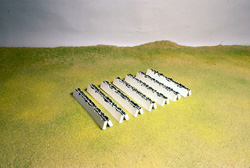

A proposal submitted to and rejected by the Hakone Museum, Japan.
Black stone outcroppings will emerge within white marble furrows, invited only by the warming winds of spring.
The changes of the seasons in this mountainous region of Japan, from fall through its winter snows, and on through the thawing to summer, offer essential elements for the development of "Blossom".
During the fall in that region, 21 lengths of 2" diameter iron pipes would be anchored vertically in level ground leaving 12" above, arranged in seven rows, oriented north/south, 3 pipes to a row, 4' apart, each row being separated by 3'. A 2" deep by 1/4" groove having been cut into the top of each pipe, is aligned along the axis of the rows. In the fall before the snows, seven 12' x 4" x 1/4" flat lengths of stainless steel are placed as blades into the grooves along each of the rows. As the winter snow arrives it is tamped down evenly over the entire footprint of the piece until it is firm and level with the tops of the blades. Then a heavily waxed wooden screeding form, 4" high having seven bays, each 3' x 12' including 1" dividers, is placed on top of the snow, aligning with and centering the blades directly under each bay. A thin layer of biodegradable insulation is spread on the snow within the form to shield the concrete from the cold as it sets. 3" obsidian aggregate is placed in the form filling it along with re-bar that is placed parallel with the blades. 16-gauge stainless steel wires are tied from re-bar to re-bar across the blades at 1' intervals throughout, so as ultimately to control the movement of the concrete slabs, as the snow melts away beneath holding them back close to the blades when they break while adopting their final form. A white marble-filled cement mix is then poured into all seven bays vibrated and screeded evenly down into the aggregate as though the seven bays were a single slab. After the concrete sets the screeding form is removed and the piece waits for a spring thaw. Without the supporting snow the entire weight of each of the concrete castings rests centered on its respective blade. The seven sections, now separate, not having been re-enforced across the blades and being filled with large-sized smooth-surfaced aggregate, break open along their axises above the blade and the sides fold slowly down revealing within the breaks the black aggregate as well as flashes of the controlling steel beneath.
At the seasons' command obsidian striped marble furrows emerge.